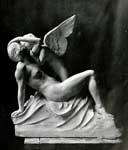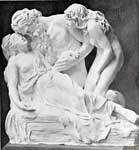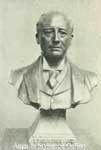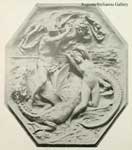Sculptures

Nymph and merman,

Hylas

Joy winged,

Harry Vardon

The River Gods and Ophelia

Alfred Hillier

Cardinal Newman

A Vision

Dreams

Perseus and Andromeda
Henry Alfred Pegram (July 27, 1862 – March 25, 1937[1]) was a British sculptor, an exponent of the New Sculpture movement.
Life
Pegram was born in London and received his first artistic education at the West London School of Art. Already in 1881 and in 1883 he won prizes at the National Art Competitions. In 1881, he entered the Royal Academy schools, where he again won prizes in 1882, 1884, and 1886. In 1887 he left the school and worked until 1891 as assistant to Hamo Thornycroft. He became a member of the Art Workers’ Guild in 1890, an Associate of the Royal Academy in 1904 and finally a Royal Academician in 1922. From 1890, Pegram was commissioned for numerous building decorations and statues. In 1913, he was one of the ten sculptors selected to work on the city hall of Cardiff, for which he sculpted the figure of Llewelyn the Last.[2] He died in 1937 in his home in Hampstead, London.[1]
Prizes
Bronze medal at the Paris International Exhibition of 1889 (for Death Liberating a Prisoner)[3]
Gold medal at Dresden, 1897 (for The Last Song)[2]
Silver medal at the Paris International Exhibition of 1900 (for a life-size plaster cast of Sibylla Fatidica, a marble version was presented in 1904 to the Tate.)[3]
Works (incomplete list)
Industry and Britannica, entrance of the Imperial Institute, London. (1891-1892)[4]
Ignis Fatuus or Misleading Light (1889).[3]
The Last Song (1897).[2]
Bronze candelabra in St. Paul's, London (1897).[1]
Sibylla Fatidica (1900-1904).[3]
Monument to Ninon Michaelis at Kensal Green Cemetery (approx 1901).
Reliefs at St Paul's Girls' School, Brook Green. (1903)[5]
"The Bather" friezes at Buckingham Gate no. 20, Westminster, London.[4]
Statue of Thomas Browne in Norwich (1905).[2]
Into the Silent Land (1905).[2]
By the Waters of Babylon (1906).[2]
Statue of Sir John Logan Campbell in Auckland (unveiled May 24, 1906).[1][6]
Stone frieze at the Aston Webb building of the Birmingham University (1907).[7]
Statue of Cecil Rhodes in Cape Town (1910).[1]
Nereus and Galatea (1911).[2]
Chance (1913).[2]
Figure of Llewelyn the Last at Cardiff City Hall.[2]
Ophelia and the River Gods (1914).[2]
Edith Cavell monument in Norwich (1917).[8]
Victory on the War memorial at Cunard building, Liverpool.[4]
Hylas (1922), installed in 1933 in the Rose garden, Regent's Park, London.[2]
Preston Cenotaph in Market Square, Preston, Lancashire (1926).[4]
Statue of Sir Robert Hart in Shanghai.[1]
References
^ a b c d e f Chamot, M.; Farr, D.; Butlin, M.: The Modern British Paintings, Drawings and Sculpture, London 1964.
^ a b c d e f g h i j k Quinlan, M.: Henry Alfred Pegram. URL last accessed 2008-08-22.
^ a b c d Wengraf, P.: Henry Alfred Pegram. URL last accessed 2008-08-22.
^ a b c d Lawson, G.: Pegram, Henry Alfred, version of 2008-08-13. URL last accessed 2008-08-22.
^ Hammersmith and Fulham Historic Buildings Group: St Paul's Girls' School. URL last accessed 2008-08-22.
^ Unveiling the Campbell Statue Hawera & Normanby Star, May 25, 1906. URL last accessed 2008-08-22.
^ Royal Institute of Architects: Item RIBA20226. URL last accessed 2008-08-22.
^ Cocke, R.; Cocke, S.: Public sculpture in central Norwich, The Norwich Society, 2007. URL last accessed 2008-08-22.
From Wikipedia. Text is available under the Creative Commons Attribution-ShareAlike License
